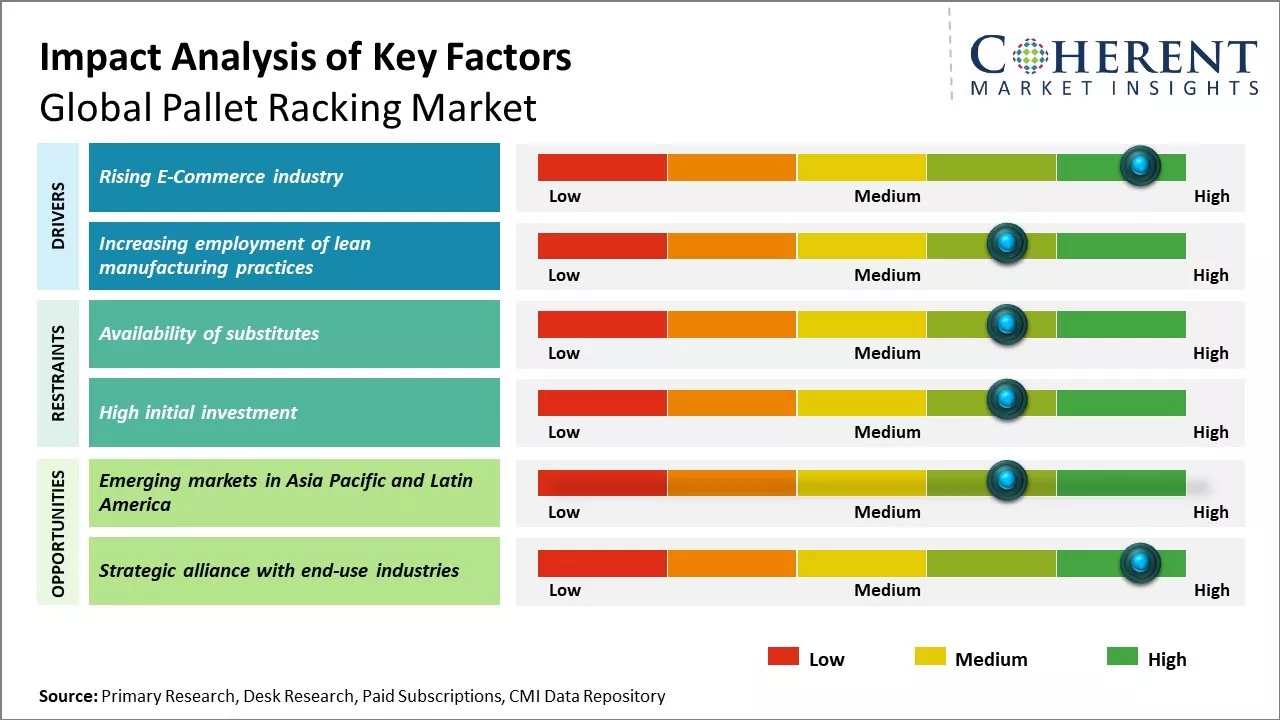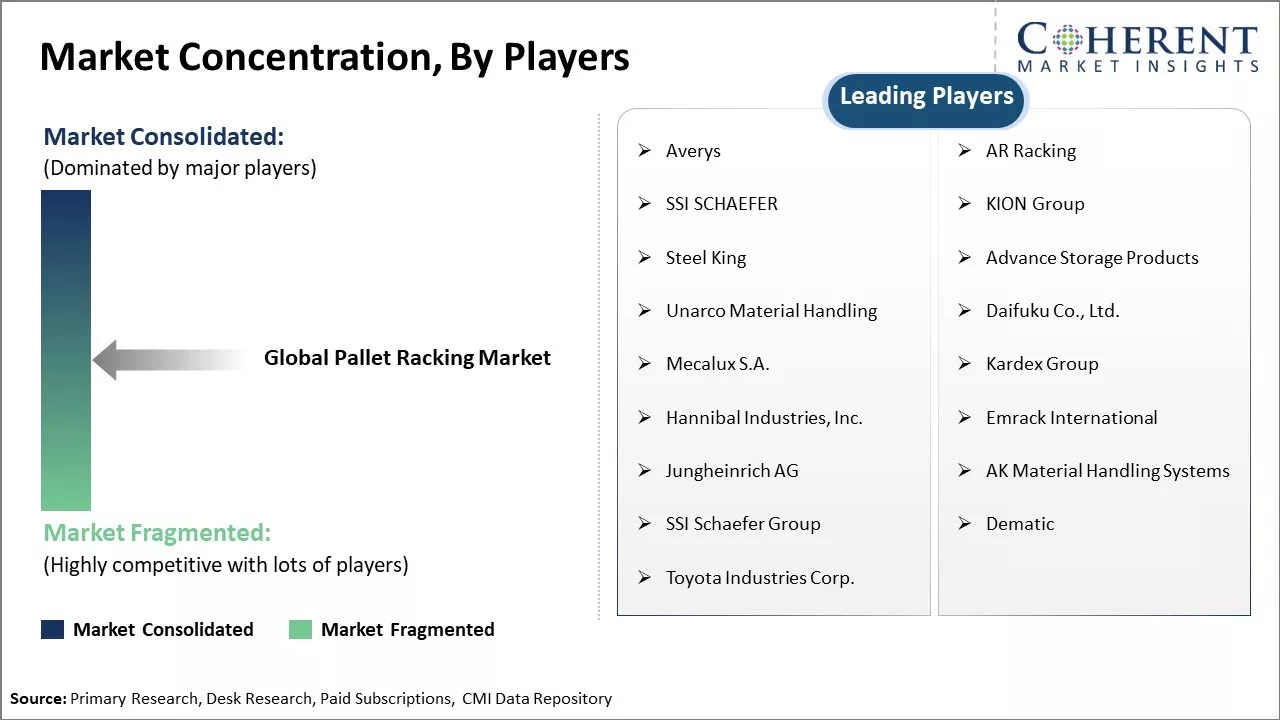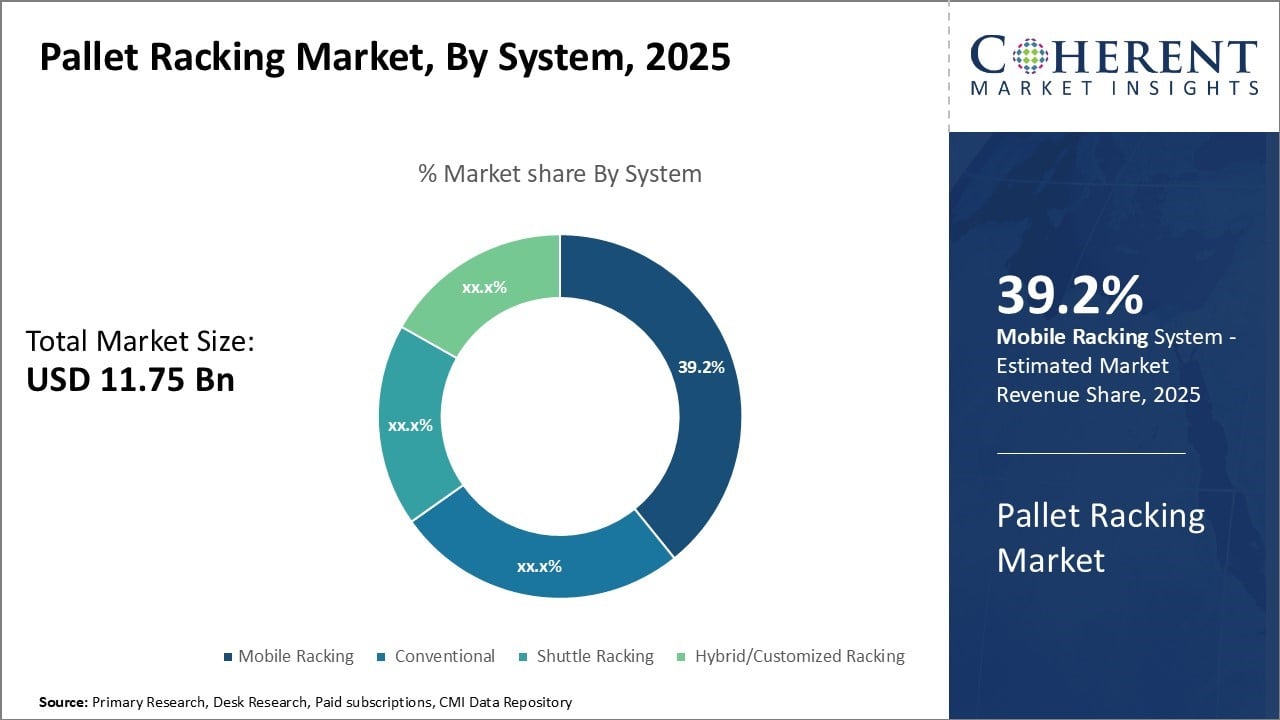Pallet Racking Market Size and Forecast – 2025 to 2032
The pallet racking market is estimated to be valued at USD 11.75 Bn in 2025 and is expected to reach USD 22.19 Bn by 2032, exhibiting a compound annual growth rate (CAGR) of 9.5% from 2025 to 2032.

To learn more about this report, Download Free Sample
Key Takeaways
- Based on System, Conventional segment is projected to account for 39.2% of the global market in 2025, owing to its ability to offer efficiency gains compared to other systems.
- Based on System Racking Type, Selective Racking segment is expected to capture 32.8% share of the market in 2025, due to ability to offer optimal balance of storage and access.
- Based on Load Capacity the 3-15 Ton segment is projected to command 31.7% share of the market in 2025, driven by its advantages in optimizing warehousing capital investments.
- Based on Region, North America is set to dominate the global market with a 37. 1% share in 2025.
Market Overview
The pallet racking market demand has been witnessing significant growth over the past few years. Key factors driving the demand for pallet racking include growth of the e-commerce industry and the need for efficient warehouse management. There has been a rising demand for pallet racks from industries such as food and beverage, pharmaceutical, and manufacturing, among others. Efficient warehousing strategy has become important for industries to optimize inventory management and reduce overall operational costs. This has boosted the adoption of pallet racking systems globally. Advancements in racking technology offering features such as adjustable pallet beams, roll formed construction, and integrated fire protection are expanding the application areas of pallet racks.
Current Events and Its Impact
|
Current Event |
Description and its Impact |
|
E-Commerce Expansion and Automation Trends |
|
|
Global Steel Price Volatility and Supply Chain Disruptions |
|
Uncover macros and micros vetted on 75+ parameters: Get instant access to report
End User Feedback and Unmet Needs for the Pallet Racking Market
End User Feedback
- Safety and Structural Issues
- Overloading racks beyond rated capacity, causing bent beams, deformed columns or braces.
- Impact damage from forklifts, collisions, or vehicles damaging uprights or beams.
- Missing or loose safety pins / safety clips in beam connections.
- Maintenance & Inspection Lapses
- Lack of regular inspection schedules, delayed or deferred maintenance.
- Use of “quick fixes” or ad hoc welding / repairs instead of proper engineered solutions.
- Poor Layout, Inefficient Space Usage
- Warehouses under‐utilizing vertical space; racks not tall enough, beams not adjustable to better match product sizes.
- Aisles too narrow or rack placement poor, leading to difficulty in maneuvering, slow retrieval times, or blocked access.
- Compatibility, Component Availability & Upgrades
- Difficulty obtaining components / replacement parts for specific rack systems (especially older or discontinued lines).
- Incompatibility between racks from different manufacturers, making expansion or repairs harder.
- Mis‐estimation of Requirements
- Underestimating load weights, pallet dimensions, forklift reach, UDL (Uniformly Distributed Load) vs point loads etc.
- Buying rack systems without considering future growth, changes in inventory mix or turnover.
Unmet Needs
- Flexible, Modular / Reconfigurable Systems: Systems that can be adjusted as inventory, product shape/size, or throughput changes. E.g. adjustable beam heights, mixable components, modular add‑ons.
- Better Component Standardization & Spare Part Availability: Universal or compatible components so that replacements are easier, and so that users are not locked into one brand or line; rapid access to quality spares.
- Faster & More Reliable Delivery Lead Times: Especially for custom or non‑standard racks, shorter lead times are key. Delays impede operations and planning.
- Sensors / Monitoring / Smart Safety Features: Technologies to detect damage (e.g. beam deflection), overloading, impact damage, or misalignment; alerts when safety components are missing or loose.
- Improved Layout & Design Support: Tools or services (software, consulting) to help with optimal rack layout (space, flow, picking path), to ensure rack design matches product mix and warehouse operations.
Market Trends
Rising E-commerce industry
With the rapid rise of e-commerce and online retail over the past decade, the need for efficient warehouse storage solutions has grown tremendously. As more consumers opt to purchase goods online rather than visiting physical stores, companies have had to scale up their fulfillment operations and distribution networks to meet demand. Pallet racking has emerged as a go-to solution for these warehouses and distribution centers, as it allows for high density storage of products on pallets in an organized and easily accessible manner.
Pallet racking maximizes otherwise empty floor space, which is crucial for e-commerce companies dealing with large and frequent shipments. It enables fast retrieval of items for order picking and also returns processing. The just-in-time nature of e-commerce supply chains requires reliable and fluid movement of goods within warehouses, which pallet racks facilitate better than traditional shelving or bin storage.
Leading online retailers recognize that robust inventory management through effective storage systems like pallet racks is key to maintaining excellence in fulfillment operations. As e-commerce continues its strong growth worldwide, it will drive greater uptake of pallet racks by third-party logistics providers and product manufacturers aiming to meet the warehousing needs of digital commerce.
Increasing employment of lean manufacturing practices
In recent years, manufacturers have been under constant pressure to optimize production processes, reduce operational costs, and improve efficiencies. This has led to the growing implementation of lean manufacturing methods across industries. A core pillar of lean is maintaining low inventory levels through minimal waste and maximum throughput.
Pallet racking is increasingly being used by manufacturing plants to support lean goals. It facilitates just-in-time inventory management by allowing the fast and accurate retrieval of products or components as needed on the production line. Pallet racks are also versatile - they can be reconfigured easily to respond to changes in product designs or demands. This helps manufacturers eliminate over-processing and wait times. The highly organized storage provided by pallet racks further aids in visual management practices that lean relies upon.
Pallet Racking Market Insights, by System - Potential for Efficiency Gains is Driving the Conventional Racking Segment
In terms of system, conventional is expected to contribute 39.2% share of the market in 2025, owing to its ability to offer efficiency gains compared to other systems. Conventional pallet racking systems are designed to optimize space utilization through efficient storage of palletized loads.
They allow easy access to loads through simple selective racking designs while maximizing the vertical storage potential. This makes them highly suitable for storing large volumes of products and for operations requiring frequent put-away and retrieval of goods. Their robust and durable construction also ensures longevity of the system with minimal maintenance requirements.
For instance, in September 2025, AR Racking installed conventional double-deep racking system for the new Nexsys Distribution Centers in Chile and Colombia.
Pallet Racking Market Insights, By System Racking Type - Driving Selective Racking Segment with Ease of Access and Storage
In terms of system racking type, selective racking is expected to contribute 32.8% share of the market in 2025, owing its ability to offer optimal balance of storage and access. Selective pallet racking systems are designed for storage and quick retrieval of loads on a first-in, first-out (FIFO) basis.
These racks allow to place and remove pallets from one side with the help of features like rollers, rails and intermediate decks. This offers easy access to loads at various storage levels. At the same time, selective racks facilitate efficient storage through their vertical layouts that maximize shelf space usage. They are highly flexible and can accommodate varying pallet sizes, loads and throughput requirements.
For instance, Massey Rack, a trusted supplier of new and used warehouse storage solutions, has launched its redesigned website, offering a streamlined experience for customers. The new site showcases a wide range of racking systems—including selective pallet racks, cantilever, pushback racks, wire decking, shelving, and custom layouts—highlighting the company’s commitment to maximizing warehouse efficiency, safety, and customer satisfaction.
Pallet Racking Market Insights, by Load capacity - 3-15 Ton Load Capacity Optimizing Capex in Warehousing
In terms of load capacity, the 5 - 15 Ton segment is expected to contribute 31.7% of the market share in 2025, driven by its advantages in optimizing warehousing capital investments. Pallet racks with 5–15-ton capacities are optimally designed to accommodate general storage and distribution requirements of most warehousing operations. Their versatile design suits storage of a variety of products, packaging types and pallet loads.
Further, racks in this mid-range load class offer higher weight carrying capabilities than lower rated racks. This helps maximize storage and load volume without compromising on strength or stability of the system. At the same, racks with ratings between 5-15 tons have lower material and manufacturing costs compared to high-capacity racks.
As a result, they deliver optimal return on capital investments for warehousing projects. Their balanced price-performance also makes them highly suitable for multi-product distribution centers. As companies increasingly focus on driving warehousing efficiencies to reduce capital costs, pallet racks with 5–15-ton load capacity are expected to fulfill the needs of majority of warehousing segments.
Regional Insights

To learn more about this report, Download Free Sample
North America Pallet Racking Market Analysis & Trends
North America has been the dominating region in the global pallet racking market over the past decade. The region is expected to account for 37.1% of the market share in 2025. The presence of major players operating in the region, such as Daifuku, Mecalux, and Interlake Mecalux, has ensured a strong supply and distribution network across the key countries in this region.
In addition, North America accounts for over 30.5% of the world's third-party logistics market. This has further strengthened the demand for sophisticated warehouse solutions such as pallet racking from a diverse set of industries including retail, food and beverages, pharmaceutical among others.
For instance, in January 2025, AR Racking, company specialized in manufacturing, designing, calculating and installing storage solutions, strengthens its presence in North America with the creation of its US subsidiary and the opening of its office in Charlotte (North Carolina).
Asia Pacific Pallet Racking Market Analysis & Trends
Asia Pacific region has emerged as the fastest growing market for pallet racking globally. Countries such as China, India, and Vietnam are witnessing exponential growth in the e-commerce and logistics sectors on the back of rising disposable income, growth of middle-class population, and increasing number of internet users.
This has driven the need for modern warehousing solutions from both global as well as domestic companies engaged in distribution and supply chain activities. The availability of low-cost labor and land in the Asia Pacific region has also attracted many manufacturing companies to establish facilities for exports. This has further augmented pallet racking installation across the region.
Pallet Racking Market Outlook Country-Wise
The U.S. Pallet Racking Market Trends
The U.S. pallet racking market is expanding due to the rise of e‑commerce, growth in third‑party logistics (3PL), and increased demand for high‐density storage solutions in fulfillment centers. Selective pallet racking remains the dominant product type, offering flexibility and ease of access, while push‑back, pallet‑flow, and other high density/drive‑in systems are gaining popularity in space‑constrained warehouses.
Meanwhile, automation, IoT, and integration with Warehouse Management Systems (WMS) or Automated Storage & Retrieval Systems (AS/RS) are increasingly standard, helping with real‑time tracking, safety monitoring, and efficiency.
For instance, In December 2024, U.S. Pallet Racks, Inc. launched as a Premier Stocking Distributor for Nucor Warehouse Systems, providing pallet racks and other material handling equipment in the south.
China Pallet Racking Market Trends
China’s pallet racking market is expanding steadily as industrialization, e‑commerce, cold chain, and logistics infrastructure grow. Key trends include strong demand for selective pallet racking (the largest/rising product segment) due to its flexibility and lower costs. There is also growing adoption of more dense, high‑throughput systems like drive‑in, push‑back and flow racking in factories & warehouses with limited floor space.
Integration of automation, IoT and real‑time inventory tracking is becoming more common to improve efficiency in large distribution centers. Lastly, sustainability (eco‑friendly materials, energy‑efficient designs) and customization (tailored racking for specific industry needs) are rising in importance.
Market Concentration and Competitive Landscape

To learn more about this report, Download Free Sample
Analyst Opinion (Expert Opinion)
The pallet racking market continues to grow driven by increasing demand from the logistics and warehousing sectors. Greater focus on efficient warehouse management practices and adopting new storage technologies are fueling the adoption of pallet racking solutions globally.
North America currently dominates the pallet racking market owing to a strong presence of major logistics companies in the region. However, Asia Pacific is expected to witness the fastest growth in the coming years with the expansion of e-commerce and growth of the logistics infrastructure in countries like China and India.
Technological advancements providing safer and smarter racking systems will open up new opportunities, supply chain disruptions caused due to geopolitical issues posed a major challenge to market players in 2023. Sustainability also remains an important consideration, with customers demanding racking solutions made of recycled materials. High material and installation costs can discourage certain price-sensitive customers.
Adoption in non-traditional industries beyond logistics also provides a significant opportunity. Popularity of just-in-time manufacturing and growing need for efficient inventory management across sectors like food and beverage and manufacturing are expanding the scope for pallet racking.
Pallet Racking Industry News
- In September 2025, Corporación Colombiana de Logística (CCL), one of the leading logistics operators in Colombia with a nationwide presence and distribution from the main cities, turned to AR Racking for the extension of its warehouse in Barranquilla.
- In September 2024, Nidec OKK announced to launch Stereoscopic Pallet Stocker that Meets Automation and Labor-saving Needs, and Unveil It with Five-axis Stereoscopic Machining Center VB-X350 at AMB 2024 in Germany.
Market Report Scope
Pallet Racking Market Report Coverage
| Report Coverage | Details | ||
|---|---|---|---|
| Base Year: | 2024 | Market Size in 2025: | USD 11.75 Bn |
| Historical Data for: | 2020 To 2024 | Forecast Period: | 2025 To 2032 |
| Forecast Period 2025 to 2032 CAGR: | 9.5% | 2032 Value Projection: | USD 22.19 Bn |
| Geographies covered: |
|
||
| Segments covered: |
|
||
| Companies covered: |
Averys, AR Racking, SSI SCHAEFER, KION Group, Steel King, Advance Storage Products, Unarco Material Handling, Daifuku Co., Ltd., Mecalux S.A., Kardex Group, Hannibal Industries, Inc., Emrack International, Jungheinrich AG, AK Material Handling Systems, SSI Schaefer Group, Dematic, and Toyota Industries Corp. |
||
| Growth Drivers: |
|
||
| Restraints & Challenges: |
|
||
Uncover macros and micros vetted on 75+ parameters: Get instant access to report
Market Opportunities: Emerging markets in Asia Pacific and Latin America
The pallet racking market in emerging economies of Asia Pacific and Latin America is poised to provide significant growth opportunities over the coming years. These regions have been witnessing rising industrialization and manufacturing activities to cater to the growing domestic as well as global demand. The governments in many countries have introduced favorable policies and initiatives to boost infrastructure development and improve logistics capabilities.
Market Segmentation
- System Insights (Revenue, USD Bn, 2020 - 2032)
- Mobile Racking
- Conventional
- Shuttle Racking and Hybrid/Customized Racking
- System Racking Type Insights (Revenue, USD Bn, 2020 - 2032)
- Cantilever Racking
- Selective Racking
- Push Back Racking
- Drive-In Racking
- Pallet Flow Racking
- Others
- Load Capacity Insights (Revenue, USD Bn, 2020 - 2032)
- Up to 5 Ton
- 5 - 15 Ton
- Above 15 Ton
- Regional Insights (Revenue, USD Bn, 2020 - 2032)
- North America
- U.S.
- Canada
- Latin America
- Brazil
- Argentina
- Mexico
- Rest of Latin America
- Europe
- Germany
- U.K.
- Spain
- France
- Italy
- Russia
- Rest of Europe
- Asia Pacific
- China
- India
- Japan
- Australia
- South Korea
- ASEAN
- Rest of Asia Pacific
- Middle East & Africa
- GCC Countries
- Israel
- Rest of Middle East & Africa
- Key Players Insights
- Averys
- AR Racking
- SSI SCHAEFER
- KION Group
- Steel King
- Advance Storage Products
- Unarco Material Handling
- Daifuku Co., Ltd.
- Mecalux S.A.
- Kardex Group
- Hannibal Industries, Inc.
- Emrack International
- Jungheinrich AG
- AK Material Handling Systems
- SSI Schaefer Group
- Dematic
- Toyota Industries Corp.
Source
Primary Research Interviews
- Pallet racking manufacturers and suppliers
- E-commerce platform operators
- Warehouse automation solution providers
- Industrial storage system integrators
- Others
Databases
- Global Trade Atlas
- Euromonitor International
- Others
Magazines
- Material Handling & Logistics
- Warehouse Management Magazine
- Industrial Distribution Magazine
- Supply Chain Management Review
- Others
Journals
- International Journal of Production Economics
- Journal of Supply Chain Management
- International Journal of Physical Distribution & Logistics Management
- Others
Newspapers
- Financial Times
- The Wall Street Journal
- Reuters Business News
- Bloomberg Industrial News
- Others
Associations
- Material Handling Industry (MHI)
- International Warehouse Logistics Association (IWLA)
- Storage Equipment Manufacturers' Association (SEMA)
- Council of Supply Chain Management Professionals (CSCMP)
- Others
Public Domain Sources
- U.S. Census Bureau Economic Data
- European Commission Industrial Statistics
- Ministry of Commerce and Industry Reports
- International Trade Administration Data
- Others
Proprietary Elements
- CMI Data Analytics Tool
- Proprietary CMI Existing Repository of information for last 8 years
*Definition: The pallet racking market refers to the industrial equipment used for the efficient storage and organization of palletized goods in warehouses and distribution centers. Pallet racking systems consist of vertical frames, horizontal beams, and load bearing supports that allow multiple pallets to be stored in a small footprint both vertically and horizontally. They maximize storage capacity and facilitate the efficient retrieval of loads using forklifts and other lifting equipment. Pallet racking markets provide various rack configurations, structural components, and accessories to meet the specific storage and inventory management needs of customers across industries.
Share
Share
About Author
Kalpesh Gharte is a senior consultant with approximately 5 years of experience in the consulting industry. Kalpesh holds an MBA in Operations and Marketing Management, providing him with a strong foundation in market strategy and analysis. He has contributed to various consulting and syndicated reports, delivering valuable insights that support informed business decisions
Missing comfort of reading report in your local language? Find your preferred language :
Transform your Strategy with Exclusive Trending Reports :
Frequently Asked Questions
EXISTING CLIENTELE
Joining thousands of companies around the world committed to making the Excellent Business Solutions.
View All Our Clients

